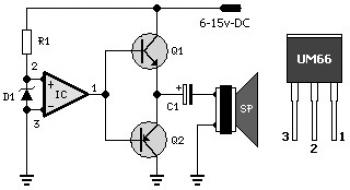This is the UM66 music generator circuit, of course this circuit uses UM66 as the main component to generate the signal of music / melody. UM66 operates on a supply voltage of 3V. The required 3V supply is given through a zener regulator. The transistor Q1 and Q2 is a push pull amplifier to drive the loudspeaker, so the music signal from pin 1 IC UM66 can be heard loudly. A class A amplifier can be used before push pull amplifier to minimize the noise and improve the output sound quality. UM66 is a 3 pin IC package just looks like a BC547 transistor.
Components list:
R1 = 4.7K
C1 = 10uF-25v
D1 = 3.3v Zener
Q1 = SK100
Q2 = SL100
IC = UM66
SP = 8 ohm
UM66 Pin Configuration:
- Output : Melody Output
- +Vdd : Positive power supply
- -Vss : Negative Power supply
UM66T Features:
- Voltage rating: 1.3V to 3.3 V
- 62 Note ROM Memory
- Power on reset
About Audio Amplifier
An audio amplifier is an electronic amplifier that amplifies low-power audio signals (signals composed primarily of frequencies between 20 - 20 000 Hz, the human range of hearing) to a level suitable for driving loudspeakers and is the final stage in a typical audio playback chain.
The preceding stages in such a chain are low power audio amplifiers which perform tasks like pre-amplification, equalization, tone control, mixing/effects, or audio sources like record players, CD players, and cassette players. Most audio amplifiers require these low-level inputs to adhere to line levels.
While the input signal to an audio amplifier may measure only a few hundred microwatts, its output may be tens, hundreds, or thousands of watts. More explanation about power audio amplifier can be found at wikipedia.org
An audio amplifier is an electronic amplifier that amplifies low-power audio signals (signals composed primarily of frequencies between 20 - 20 000 Hz, the human range of hearing) to a level suitable for driving loudspeakers and is the final stage in a typical audio playback chain.
The preceding stages in such a chain are low power audio amplifiers which perform tasks like pre-amplification, equalization, tone control, mixing/effects, or audio sources like record players, CD players, and cassette players. Most audio amplifiers require these low-level inputs to adhere to line levels.
While the input signal to an audio amplifier may measure only a few hundred microwatts, its output may be tens, hundreds, or thousands of watts. More explanation about power audio amplifier can be found at wikipedia.org
This is a video tutorial about how to a very simple audio amplifier based on the LM386 amplifier chip. It can be built for less than $20 (or might be less than $8 in some countries) and used to amplify any low level audio signal including a guitar, bass or mp3 player.
Watch the video:

No comments:
Post a Comment